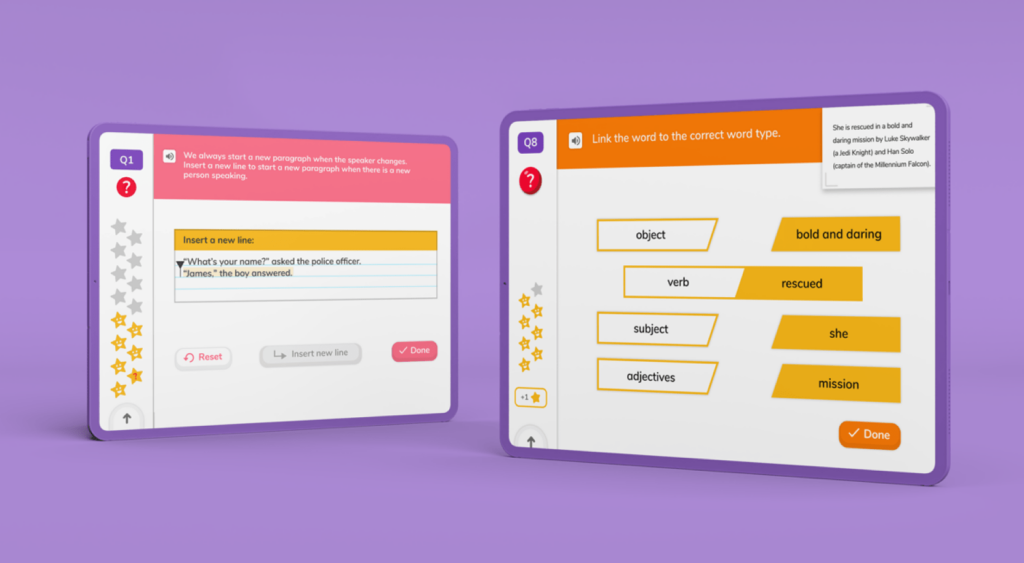

Learn what’s taught in the Year 1 English Curriculum across the subjects of reading, comprehension, writing, composition, and grammar.

Author
Mhairi Sim
Published
August 2024


Learn what’s taught in the Year 1 English Curriculum across the subjects of reading, comprehension, writing, composition, and grammar.

Author
Mhairi Sim
Published
August 2024


Learn what’s taught in the Year 1 English Curriculum across the subjects of reading, comprehension, writing, composition, and grammar.

Author
Mhairi Sim
Published
August 2024


Key takeaways
Table of contents
The Year 1 English national curriculum starts the ball rolling on the skills our kiddos will cover over the rest of their time at primary school. They’ll be taught skills across reading, writing, and spoken language, building on these each year.
With this in mind, there’s a lot packed into this exciting year for our littlest learners! We’ve put together this guide to the Year 1 English curriculum that’ll cover what’s taught through the year, any assessments that kiddos will face and how to help your learner along the way.
In Year 1, our kiddos are mainly getting to grips with the world of phonics and learning skills for how to read and spell a range of different types of words. These skills are checked at the end of the year with the Phonics Screening Check in June.
This year, learners will also aim to refine their handwriting skills, use some basic forms of punctuation in their written work, and develop their speaking and listening skills.
Teachers will spend time developing reading comprehension skills with their students. These skills are the foundation learners will continue to build on throughout their primary and secondary school journeys.
In the Year 1 national curriculum English, reading is split into two different categories; word reading and comprehension. Let’s explore these in a little more detail.
A learner’s ability to read starts with their ability to read individual words and groups of letters. This is why word reading is an important focus in their KS1 education and why students will sit a phonics assessment at the end of Year 1.
To prepare for their phonics assessment, Year 1 students will learn how to read a range of different words, with plenty of practice reading aloud. This will help them learn how to blend the initial phonic sounds they have learned in reception.
In doing this, they should be able to:
In addition to simply reading the words on the page, students are also working towards understanding the meaning of those words. This is where comprehension comes in – learning to develop a deeper understanding of what they’ve read!
Working on reading comprehension allows our kiddos to learn to love reading and to see why we need this important skill in life! As a part of the national curriculum Year 1 English learners will be exposed to a wide range of different texts such as non-fiction, stories, and even poems.
As they read or listen to different texts, they’ll be encouraged to make links to their own experiences or other stories they have heard. It’s also the perfect opportunity to discuss unfamiliar words, learn about traditional tales, and even appreciate rhyming!
Developing comprehension in Year 1 allows students to build essential reading skills they’ll use throughout their school career. In Year 1, students should be encouraged to make predictions based on what they’ve learned and infer meaning (or read between the lines).
Unlock unlimited English questions
Put your skills to the test with fun exercises + learning games that are proven to boost ability!
DoodleEnglish is an app that’s filled with thousands of fun, interactive exercises covering grammar, punctuation, spelling and more!
Designed by teachers, it creates each child a unique work programme tailored to their needs, boosting their confidence and skills in English. Try it for free today!

The writing Year 1 English curriculum is split into three separate parts. Each of these covers a different element of writing.
Transcription focuses on the technical side of writing; the spelling of words and the formation of a student’s handwriting.
By the end of the national curriculum English Year 1 programme, students should be able to:
As they spend more time practising their writing, by the end of Year 1 students should confidently:
Your kiddos will also start to form lower-case letters in the correct directions. This skill develops as they are able to identify which letters belong to different handwriting ‘families’ – letters that are formed using similar movements like the letters ‘a’ and ‘d’ for example.
Writing isn’t just about spelling things correctly and having neat handwriting! In Year 1, your little ones will also be taught the basics of composing written work. This can include:
After they’ve completed their written work, they should then be able to read it aloud and discuss it with their teacher or other classmates!
Last but not least, the final part of the Year 1 English curriculum for writing is all about vocabulary, grammar, and punctuation. This element is key to ensuring that their writing is clear and easily understood!
This includes:
The full list of concepts that little ones will need to have under their belts by the end of the year can be found in the national curriculum English appendix 2 document!
A key element of the English curriculum is spoken language. This element concerns developing the ability to speak to and listen to others.
The curriculum for spoken language spans Year 1 – Year 6 with educators being advised to teach the content to a suitable level for their learners.
Learners should be encouraged to listen and respond, build their vocabulary, stay on topic during discussions, speak in a tone and volume suitable for their audience and more.
At the end of the Year 1 national curriculum English phonics skills will be put to the test!
In June, students are expected to sit a Phonics Screening Check which assess their reading abilities by testing their understanding of phonics.
During the check, students are asked to read out ~40 different words (some real words, some made up) to check their understanding of grapheme-phoneme correspondences (GPCs). As students sound out each word, the assessing teacher will mark their responses.
A good grasp of phonics has been found to have a positive impact on learners’ reading abilities. The Phonics Screening Check is a great way for schools to identify any students who might need some extra support in this area.
I’ve always found that the best way to help kiddos with the Year 1 English national curriculum is to have them practice, practice, practice those reading skills!
Have your little one practice reading words from their school work or homework, reading books at home, or even simple words you might have on a shopping list. Any chance to practice recognising letters and sounding out words is beneficial!
Another great tool you can use to help your little learners get to grips with the Year 1 English curriculum is our fantastic DoodleEnglish app. The app has thousands of curriculum-aligned games and activities that learners love – making it so much easier to get them motivated to do some revision and extra practice!
That’s it for our guide on the ins and outs of the national curriculum Year 1 English programme!
We’ve covered each element of the English curriculum, the assessments involved, and some great ways to help your learners. All that’s left is for your kiddos to have fun in this amazing year that’ll set them up for the rest of their school careers!
Book a chat with our team
If you’d like to use Doodle’s browser version, please visit this page on a desktop.
To log in to Doodle on this device, you can do so through our apps. You can find out how to download them here: